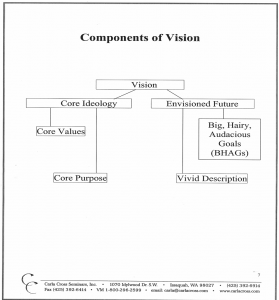

Through November and December, I’m going to help you with your 2021 business plans. You’ll find free documents from my business planning system and an invitation to a complimentary webinar. Why not subscribe and be sure not to miss a thing?
Many times, we launch right into business planning by trying to create an action plan. Unfortunately, that’s like starting at the end of a tune and trying to sing it backward. Instead of struggling through action planning, start with your vision. Is your business plan missing vision? Below is an explanation of why having a vision is so important to the success of your business plan. In fact, I believe the lack of vision in a plan leads to a demotivating and certainly uninspiring plan.
Why Vision is Important
A few years ago, business professors, Jim Collins and Jerry Porras, studied very successful companies to find out the differences between ‘stunning’ (high profits and highly regarded), and other like companies who were almost as profitable, but not so successful). They published the results in the best business book I’ve ever read, Built to Last: Successful Habits of Visionary Companies.
What did they find was the common difference between the highly profitable and merely very successful?
A common vision and values shared by every person in the company.
Porras and Collins’ conclusion was that the desire for profits isn’t the main driver for profits. The focused and tenacious vision, shared by all in the company, was the biggest determinant for profits.
Components of Vision
Your vision is made up of your core ideology and your envisioned future.
 As you can see from the chart on the right, excerpted from my business planning system, your core ideology is made up of your core values and core purpose. If you look at your life, you’ll see that the things that inspire and motivate you are the things that adhere to your belief system. That’s what this part of the vision statement says about you.
As you can see from the chart on the right, excerpted from my business planning system, your core ideology is made up of your core values and core purpose. If you look at your life, you’ll see that the things that inspire and motivate you are the things that adhere to your belief system. That’s what this part of the vision statement says about you.
Your envisioned future is made from a vivid description of this future, and BHAGs—big hairy, audacious goals. Those are goals five years out, that you really don’t think you can attain.
The Power of BHAGs
Surprisingly, as Porras and Collins found, when companies stated these goals, they actually attained them in three years! (Inspirational goals that are congruent with your core values and core ideology are powerful motivators!).
What Vision Does for Companies
Here’s Porras and Collins’s function of a vision statement:
Provides guidance about what core to preserve and what future to progress toward. Made up of core ideology and envisioned future.
Here’s an example of a vision of one of the book’s stand-out companies:
Our basic principles have endured intact since our founders conceived them. We distinguish between core values and practices; the core values don’t change, but the practices might. We’ve also remained clear that profit – as important as it is – is not why the Hewlett-Packard Company exists; it exists for more fundamental reasons.”
– John Young, former CEO, Hewlett-Packard
How to Construct your Vision
How do you want to see yourself in this business? How do you want people to talk about you and your business after you retire? What values are most important to you? What ideology do you follow in your business?
Looking back: Imagine you are at your own memorial, watching from above. What are others saying about you? What’s most memorable about you?
Voicing those BHAGs
What is a great goal you would love to accomplish in your business, but really don’t feel it’s possible for you within five years? Write it right now.
Why We Don’t Reach Those Lofty Goals
Is that goal that’s been eluding you congruent with your core values? What I mean by that is, does that goal feel comfortable to you? For instance, if that goal is that you’ll make two million dollars, and you don’t like the feeling of that much money, because your values are aligned differently, you just aren’t going to reach that goal. That, I believe is the reason many of us don’t reach some of our goals. Those goals aren’t in alignment with our core values.
Here’s what great motivational speaker Zig Ziglar said about goal-value alignment:
You can’t consistently perform in a manner that is inconsistent with the way you see yourself.
Finding your Alive, Powerful Motivation
Click here to get a copy of my vision worksheet.
. Yogi Berra said it well:Life is like baseball; it’s 95% mental and the other half is physical.





